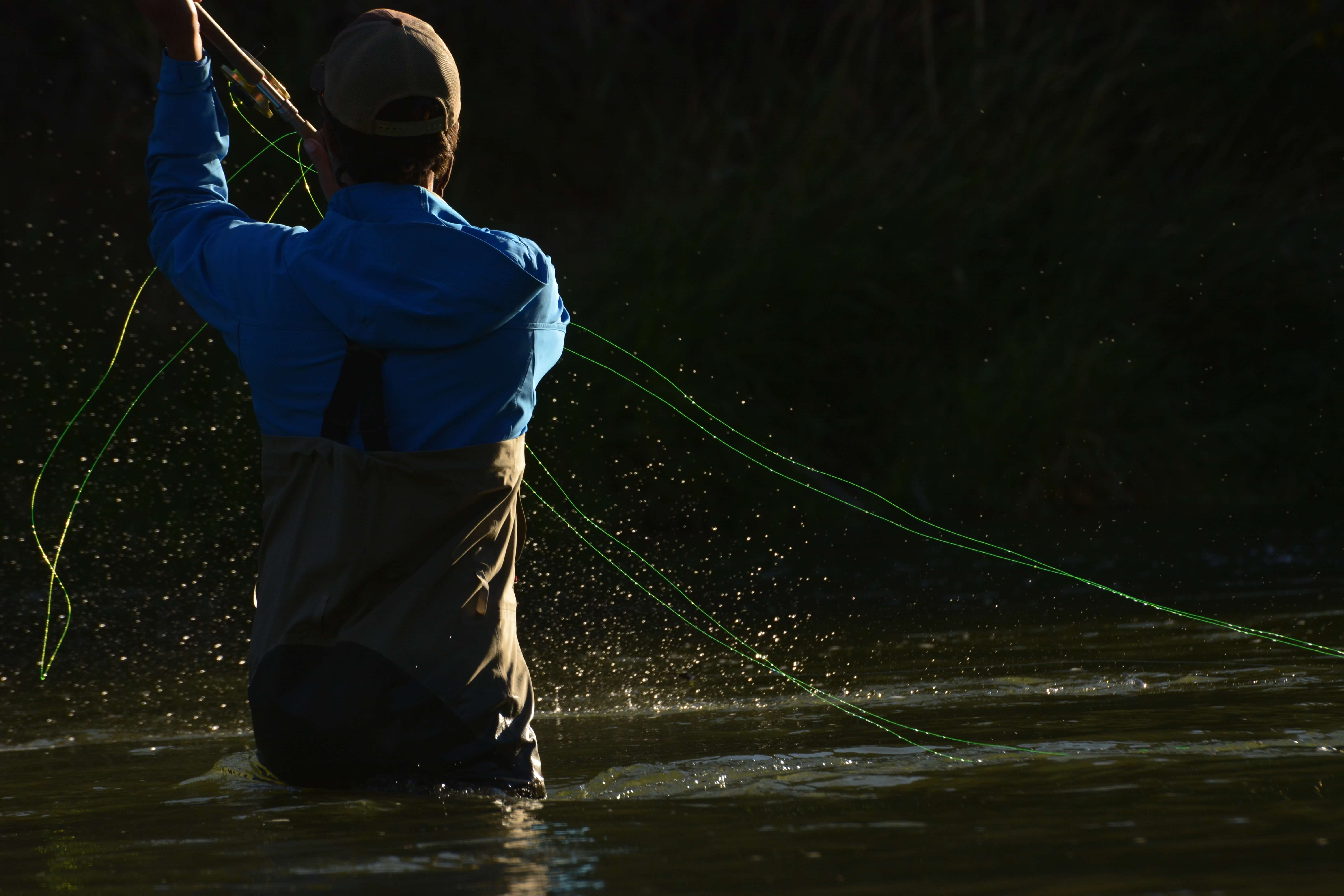Strung is back with the second installment of our “‘Spey’ Rods for Trout and Bass Heathens” series. We know that spey fishing can be pretty darn intimidating, but it doesn’t have to be the ego gut-punch that some folks make it out to be. We’ve broken down what goes into a typical spey fishing setup and how things work so you can find those fish that couldn’t be reached with your single-hand rod and an overhead cast.
Editor’s note: A modified version of this information was originally published by the author on the ECHO Fly Fishing Blog.
Spey and Switch Line Basics
Spey and switch lines can be broken up into two general categories: integrated lines and head systems. Integrated lines are one piece and cover most of the fly lines on the market. Odds are, your trout line is an integrated line. In an integrated line, the head and running line are constructed to be one piece with no discernible junction between the two parts. Head systems, on the other hand, are composed of multiple pieces that only perform when used with one another. The head is entirely separate from the running line, and many heads require an additional sink tip to cast properly.
Integrated Spey/Switch Lines
For smaller spey and switch rods.
Integrated spey/switch lines feature a one-piece head and running line to help with some of the trout-specific issues that folks sometimes have when fishing head systems. On smaller switch rods ( generally #6 and under), the line guide size is typically small enough that the loop-to-loop connections found on head systems become clunky when stripping back in to your feet. To alleviate the risk of losing fish from a stuck loop-to-loop connection, manufacturers have begun producing one-piece switch lines with the condensed head length preferred by most switch-rodders. The short head length helps when casting in tight quarters and eliminates the need for a large D-loop.
Mid and Long-Belly Spey Lines
For longer spey rods and maximum casting distance.
Traditional spey lines are integrated lines that feature a long head and long total length. They excel on long (13.5’+) rods and, by virtue of their head length, offer the opportunity for longer casts. These can be further broken down into mid-belly and long-belly lines. Mid-belly lines are characterized by a moderate belly, generally shorter than 40’. Long-belly lines feature a longer belly and maximize a person’s potential casting distance. With additional length, however, comes an additional degree of complexity when dialing in your personal casting stroke. As a rule of thumb, the longer the head, the harder it is to make a tight, pretty cast. Both styles can be fit with light-to-medium sink tips for deeper presentation or with a floating leader for surface work.
Head Systems
All head systems are composed of a running line, shooting head, and leader. Head systems can be broken into three general categories: Skagit, Scandi, and Hybrid.
Skagit Heads
For swinging flies with a sink tip.*
Skagit heads are designed to be fished with a sink tip exclusively*. Their aggressive front taper and large tip diameter help turn over heavy sink tips and large flies. Want to swing flies for salmon and steelhead? A Skagit head is the way to go. They are not designed to be fished with a tapered leader alone. While they will certainly turn over a mile-long leader, their large tip diameter creates surface crash that can spook fish that would otherwise eat a dry fly. Skagit heads are generally fished using a sustained-anchor cast. Multi-density Skagit heads are available that help anglers fish slower and lower in the water column, presenting flies at an ideal speed for fish that would otherwise let that intruder fly on by. These heads are often broken up into three densities: a floating back end, an intermediate-density middle, and a quick-sinking tip. They are still designed to be fished with a level sink tip.
*Super-short Skagit heads are fished with a floating leader by some folks, especially on single-hand rods in situations where a single-spey cast is most efficient. More on this in the next installment. See products by Airflo and OPST.
Scandi Heads
For skating flies on or near the surface with a tapered leader.*
Scandi (Scandinavian) heads are designed to be fished primarily on or near the surface. They are more delicate, featuring a longer front taper and skinnier tip diameter for presenting flies to surface-feeding fish. While some folks fish light sink tips off of their Scandi heads, they’re intended to be fished with floating, hover, or intermediate leaders. Scandi heads are typically fished using a touch-and-go style cast.
*Recent product innovations have introduced multi-density Scandi heads that are designed to be fished deeper in the water column. These heads are capable of delivering a fly into deeper water without the bulk and splash of a Skagit head. Their thinner tip diameter isn’t quite as capable of turning over big flies, but many adept Atlantic salmon and sea-run trout anglers in Europe swear by them. See products by Rio and Guideline.
Hybrid Heads
For maximum versatility.
Hybrid heads are a middle-ground between Skagit and Scandi heads. They’re less aggressive than Skagit heads, but more aggressive than Scandi heads. They can turn over moderate sink tips (generally, tips lighter/shorter than 10 ft. of T-10), or be fit with a floating leader for skating flies. For folks looking for one head for multiple fishing situations, they’re the bee’s knees. They’re also a great way to pick up touch-and-go casting without the learning curve often found with Scandi heads. See products by Airflo.
Running Lines
A running line is the level-diameter line that connects to a shooting head via a loop-to-loop connection. They can be built like a standard fly line (low-stretch core with PU or PVC coating), constructed of a single material (monofilament), or braided. Several manufacturers make many or all of the following running line types.
Coated Running Lines
For dexterity and ease of use.
Coated running lines are built a like a fly line, and will feel familiar to folks that are used to fishing integrated lines. They offer better dexterity than monofilament running lines in cold weather and are generally easier to handle. Coated running lines, however, don’t offer the same shooting distance that monofilament running lines provide. Coated running lines are available in a variety of core strengths, coating hardnesses, and densities to match each fishing situation. A basic rule: #7 rods and above should be fit with a #30 running line, while rods smaller than #7 should be fit with a #20 running line. Floating running lines are standard, while some anglers prefer intermediate running lines to get below surface hydraulics that would otherwise compromise a drag-free drift. Great for anglers of all skill levels.
Monofilament Running Lines
For maximum shooting distance.
Monofilament running lines afford greater shooting distance than a coated running line, but are less dexterous. Many anglers ‘graduate’ to monofilament running lines once they’ve cracked the code with spey casting. They cut though surface hydraulics and are less susceptible to damage. Back in the day, many anglers used standard, heavy monofilament fishing line as a running line. Today, manufacturers produce monofilament running lines that have less memory and greater feel than normal mono fishing line. Great for advanced anglers.
Braided Running Lines
For improved dexterity without sacrificing casting distance.
Braided running lines provide a happy medium for anglers looking for greater dexterity than a monofilament running line but aren’t willing to sacrifice casting distance. Built from a low-stretch core covered in a braided material, braided running lines have zero memory. Great for intermediate to advanced anglers.
Sink Tips
Sink tips allow anglers to present flies to fish that are holding in deeper water. They can be fished off of any type of head, but those with a thicker tip diameter – Skagit and hybrid-type heads – typically turn them over with greater efficiency. Sink tip density is measured in grains per foot, preceded by the letter ‘T’ (referring to the tungsten-impregnated material that allows the tips to sink). For example, T-10 weighs 10 grains per foot. Sink tips are typically of a level diameter, though tapered sink tips are also available.
Level Sink Tips
Level sink tips are what people are usually talking about when they say ‘sink tip’. They’re generally 4-15 feet in length, with most being between 10’ and 12’. They’re available in various densities, starting around 5 grains per foot (T-5) and maxing out around 20 grains per foot (T-20). Most fishing situations require tips between T-7 and T-14. The tip is looped on to the shooting head (usually a Skagit head), and fit with a short piece of level leader.
Multi-Density Tips
Multi-density tips are designed to help reduce the hinge angle between a floating head and sink tip, and offer a more direct link between you and your fly. Instead of a single density, multi-density tips combine intermediate (slow sink rate) fly line material with level-sink tungsten material. The intermediate material sinks at a slower rate than the level sink material, creating a smoother transition between head and tip. With this, the overall hinge angle is reduced to a fraction of that found with just a level-sink tip. Shallower hinge angle = fewer hang-ups. The intermediate transition also helps create a straighter line between the angler and fly, affording greater sensitivity and reducing the number of missed strikes. See products by Rio and Airflo.
Make a little bit of sense? Spey fishing doesn’t have to be an exercise in masochism. In the next installment of “‘Spey’ Rods for Trout and Bass Heathens’, we’ll cover casting types and their relative uses. Borrow a two hander from a buddy or local shop and give it a try – it’ll be your best friend when the big rivers call. If you haven’t checked it out yet, see Part 1 of the series on why a spey rod can help take your fishing to the next level.
Cover photo by Marty Sheppard.



